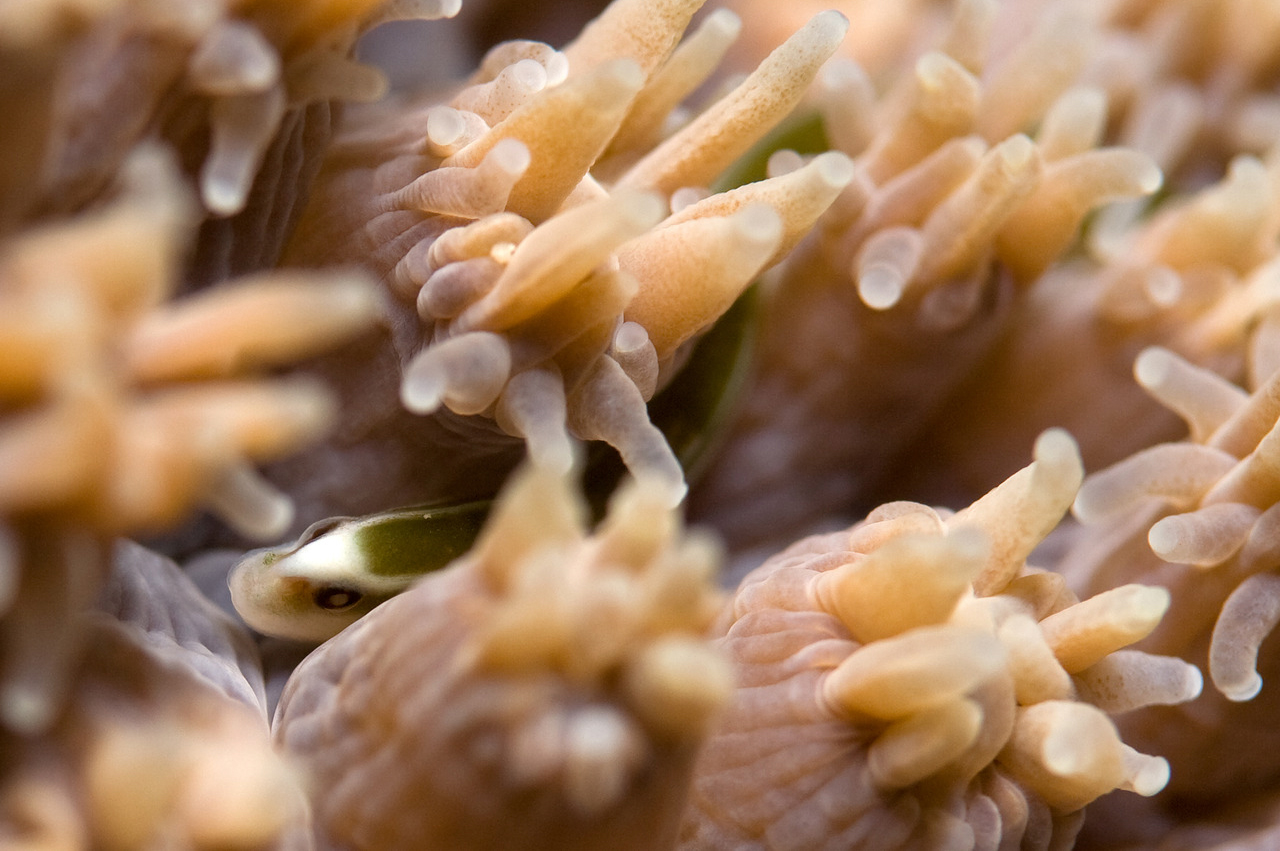Davao Pughead Pipefish, Bulbonaricus davaoensis (Herald 1953)

A Davao Pughead Pipefish, Bulbonaricus davaoensis, at Ani Island, Ogasawara, Japan, depth 8m. Source: orangkucing / http://orangkucing.tumblr.com/. License: CC BY Attribution-ShareAlike
A small reddish or greenish eel-like pipefish that lacks the tube-like snout of most pipefishes. It has a pale blue median streak, white on top of the head, and lower margins of opercles bright red. This small secretive species lives amongst the Galaxy coral Galaxea fascicularis.
Davao Pughead Pipefish, Bulbonaricus davaoensis (Herald 1953)
More Info
|
Distribution |
Only known in Australia from a single specimen collectedreat Barrier Reef off Cape Melville, Queensland. Elsewhere, the species is widespread in the tropical Indo-West Pacific, from the Western Indian Ocean off Kenya, and from the Philippines to Fiji, north to the Ryukyu Islands, Japan. Inhabits coral reefs in association with the coral Galaxea fascicularis. |
|
Features |
Dorsal fin absent in adults; Pectoral fin absent in adults; Trunk rings 16-17; Tail rings 40-45, total subdorsal rings 7.0-8.5.Frontal process rounded and spine-like; male brood pouch below 20 tail rings, pouch folds voluminous. Fins are only present in the planktonic stage and the fin-ray counts are Dorsal fin 22-26; Pectoral fin 9-13. The dorsal fin of juveniles originates on the 2nd-3rd tail ring. |
|
Size |
Reaches 4.3 cm TL |
|
Colour |
Metamorphosed individuals are greenish above with a pale blue median streak, head white anteriorly, and the ventral margins of the opercles are bright red. |
|
Feeding |
Although little is known of the feeding habits of this species, it is likely to feed on or within the coral Galaxea fascicularis. |
|
Biology |
Males brood the eggs in an enclosed pouch on the underside of the tail. Eggs are 0.5-0.6 mm diameter; deposited in two transverse rows in two layers in the brood pouch. The species has a long pelagic juvenile stage, and planktonic specimens have been collected in the upper 200 m over deep water. |
|
Conservation |
|
|
Remarks |
The planktonic and bottom-living stages of this pipefish differ markedly. Planktonic juveniles have dorsal and pectoral fins, and a typical tube-like pipefish snout. In contrast, those settled on the bottom appear ‘pugheaded' and lack dorsal and pectoral fins. |
|
Similar Species |
Bulbonaricus davaoensis has a round spine-like frontal process and lacks marginal spines or denticulations compared to the V-shaped frontal process and spinose or denticulate dorsal margins of Bulbonaricus brauni. |
|
Etymology |
The species is named davaoensis in reference to Davao Gulf, where the holotype was collected. |
|
Species Citation |
Ichthyocampus (Bulbonaricus) davaoensis Herald 1953, Bull. U.S. Nat. Mus. 202(1): 242, fig. 37. Type locality: Davao Gulf, 6°44'N, 125°46'E, Mindanao Island, Philippines, surface. |
|
Author |
Bray, D.J. & Thompson, V.J. 2025 |
|
Resources |
Davao Pughead Pipefish, Bulbonaricus davaoensis (Herald 1953)
References
Allen, G.R. & M. Adrim. 2003. Coral reef fishes of Indonesia. Zool. Stud. 42(1): 1-72.
Allen, G.R. & Erdmann, M.V. 2012. Reef fishes of the East Indies. Perth : Tropical Reef Research 3 vols, 1260 pp.
Araki, M., Uehara, K., Senou, H. & Motomura, H. 2020. First Records of the Pughead-pipefish Bulbonaricus davaoensis (Teleostei: Syngnathidae) from Japan. Species Diversity 25: 163-169 https://doi.org/10.12782/specdiv.25.163
Austin, D. & Pollom, R. 2016. Bulbonaricus davaoensis (errata version published in 2017). The IUCN Red List of Threatened Species 2016: e.T65363869A115411185. https://dx.doi.org/10.2305/IUCN.UK.2016-3.RLTS.T65363869A67618988.en. Accessed on 04 June 2024.
Dawson, C.E. 1980. Notes on some Siboga Expedition pipefishes previously referred to the genus Syngnathus. Bijdragen tot de Dierkunde 50(1): 221-226 figs 1-4 (Australian material misidentified as Enchelyocampus brauni)
Dawson, C.E. 1984. Bulbonaricus Herald (Pisces: Syngnathidae), a senior synonym of Enchelyocampus Dawson and Allen, with description of Bulbonaricus brucei n. sp. from Eastern Africa. Copeia 1984(3): 565-571. https://doi.org/10.2307/1445135
Dawson, C.E. 1985. Indo-Pacific Pipefishes (Red Sea to the Americas). Gulf Coast Research Laboratory, Ocean Springs, Mississippi. 230 pp.
Dawson, C.E. & Allen, G.R. 1978. Synopsis of the ' finless' pipefish genera (Penetopteryx, Apterygocampus and Enchelyocampus, gen. nov.). Records of the Western Australian Museum 6: 391 - 411.
Ho, H.-C. & Lin, C.-W. 2014. New records of two pughead pipefishes (Syngnathiformes: Syngnathidae: Bulbonaricus) from Taiwan. Platax 11: 25-31.
Kuiter, R.H. 2000. Seahorses, Pipefishes and their Relatives. TMC Publishing, Chorleywood, UK. 240 pp.
Kuiter, R.H. 2009. Seahorses and their relatives. Seaford, Australia : Aquatic Photographics 331 pp.
Herald, E.S. 1953. in Schultz, L.P., Herald, E.S., Lachner, E.A., Welander, A.D. & Woods, L.P. Fishes of the Marshall and Marianas islands. Vol. I. Families from Asymmetrontidae through Siganidae. Bulletin of the United States National Museum 202, v. 1: i-xxxii + 1-685, Pls. 1-74. See ref at BHL
Paulus, T. 1999. Family Syngnathidae. pp 2264-2276, in Capenter K.E. & Niem V.H. (eds) The Living Marine Resources of the Western Central Pacific. FAO Species Identification Guide For Fisheries Purposes. FAO Vol. 4. pp 2069-2790.

